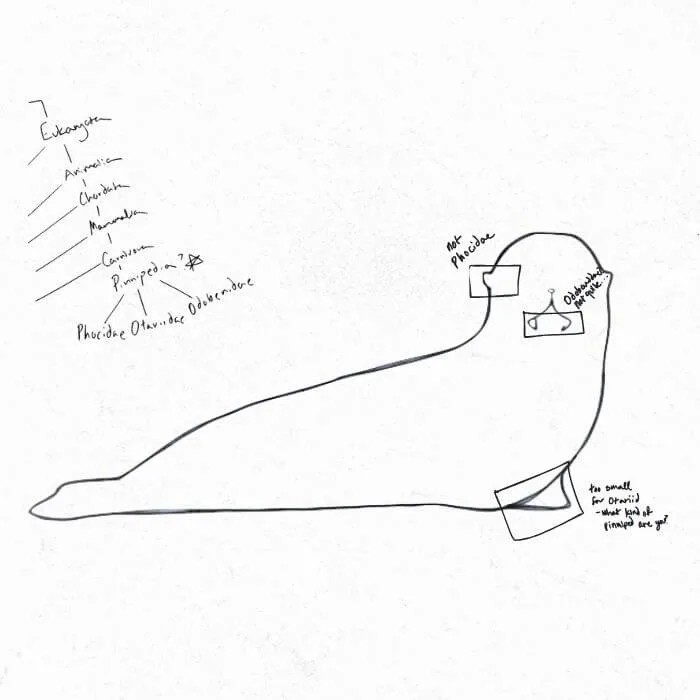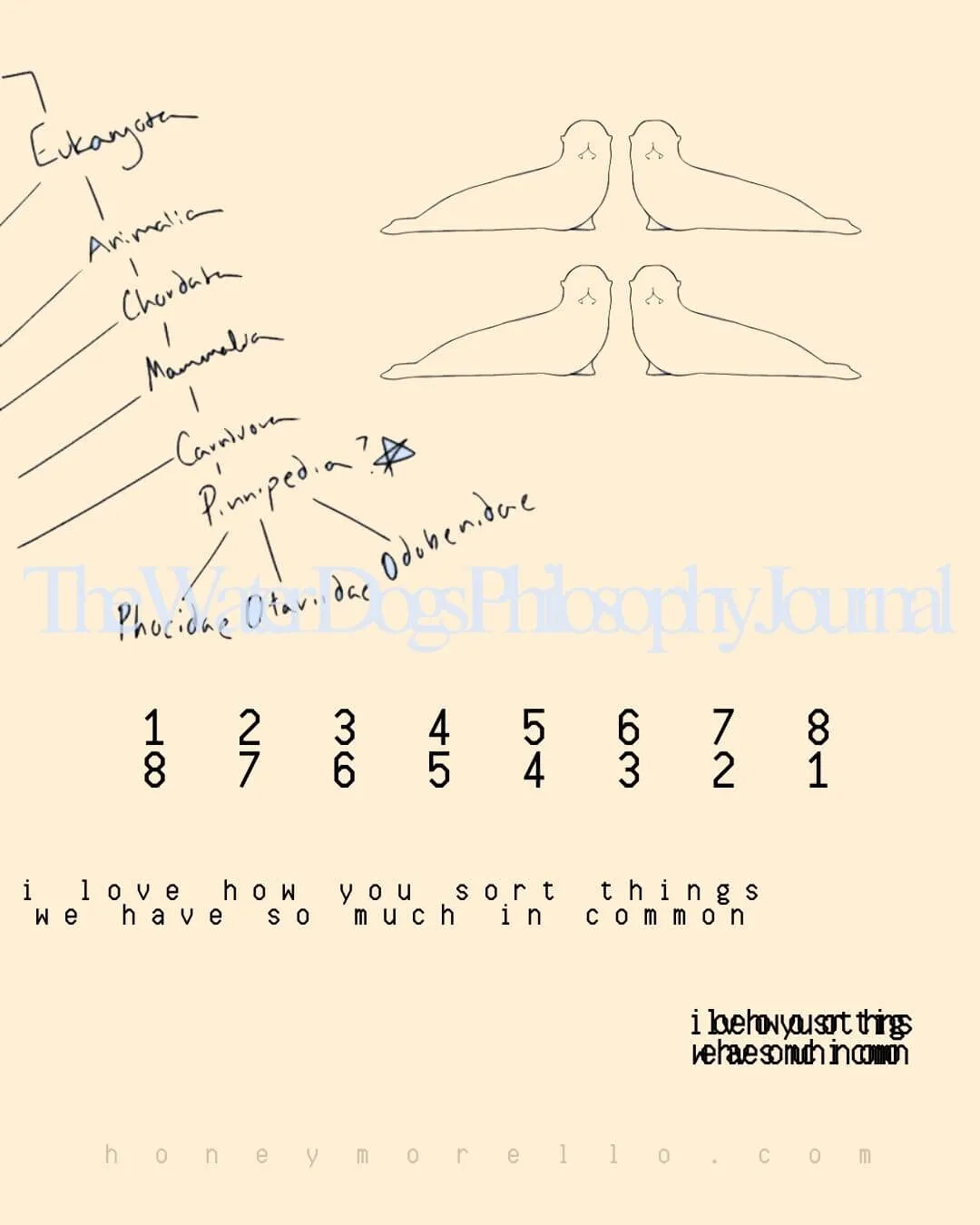About The Creature
The Not-Seal wasn't officially documented in scientific literature until the early 1980's, but tales have been told of possible iterations for hundreds if not thousands of years. From the Scottish Selkies of the 13th century to the Japanese Kabagon (spotted in New Zealand in the 1970s) to the gory and dramatic tale of the "fetal Tumor Seal” (reported on the radio show Coast to Coast in the late 1990's), pinniped cryptids abound. We really can't know for sure how old the Not-Seal is, but the concept has quite a history. The modern Not-Seal (also called the “Un-Seal”, the “new pinniped”, and in certain contexts simply “The Creature”) was first spotted by a small group of marine biologists in 1969 in Los Angeles, California who stumbled upon it while doing unrelated fieldwork. At first The Creature drew little attention because of its overt resemblance to a normal earless seal. However, upon further investigation, the biologists were surprised to notice subtle differences between The Creature and existing pinniped taxonomy. One biologist later drew the following sketch to illustrate some of the abnormalities she observed.

The Creature was not reported again until the 1980's, when multiple sightings were informally reported in California and England, plus one unlikely sighting in Lake Geneva, Switzerland. As was the case in 1969, the scientific community showed limited enthusiasm about these sightings because the Not-Seal is simply so visually similar to other pinnipeds. For this reason, information about sightings before 1993 is sparse and the history of the Not-Seal's discovery must be constructed retroactively, and with some degree of nuance and creativity. Throughout the 1990's, Not-Seal sightings skyrocketed and The Creature first experienced popularity with the general public. People all over the world claimed to have their very own experiences witnessing the Not-Seal. Shirts were sold, stuffed animal likenesses were made, “authentic” photographs were sold, traded, and collected by bona fide Not-Seal fanatics. Once advertisers caught onto the hype, the Not-Seal became the unofficial mascot of the late 1990's and early 2000's.
Marine biologists hesitated to formally add the new pinniped to seal taxonomy records for two reasons. First, no pictures of the Not-Seal sufficiently proved its distinction from known pinnipeds. Because of the subtlety of the Not-Seal's abnormalities and its somewhat coy and erratic behavior, it was very difficult for marine biologists to get photographic evidence demonstrating the Not-Seal's unique morphology. Furthermore, the popularity of the Not-Seal had preceded its official scientific discovery so quickly and intensely that deceptive material was in constant circulation. It was impossible for scientists to confidently discern between real, enhanced, and entirely manufactured images of The Creature. This persistent gap between the quality of the Un-Seal hoaxes and the scientific tools needed to verify the Un-Seal's existence, maintained by the steady march of technological advancement across the board, was termed the “Un-Seal's Paradox” by biologist and philosopher J. R. Hofstadter in March of 2000. Philosophers have since written about other modern paradoxes exemplified by the curious case of the Not-Seal, drawing a small yet passionate cult following to this budding mini-branch of niche new philosophy.
The second cause for hesitation among pinniped taxonomists was the total lack of deceased Un-Seal specimens. In all the decades since the Un-Seal's first sighting, a confirmed dead Un-Seal has still never been found. This has led many contemporary marine biologists to deem the whole idea a clever hoax, a collective trick of the mind, and/or a meme. Other marine biologists maintain that the Un-Seal is likely a real pinniped, but explanations for the lack of dead specimens vary. Some have theorized that the abnormalities which separate the Un-Seal from known pinnipeds are only visible at certain points in the Un-Seal's life cycle, and are perhaps no longer observable once The Creature has died. This theory has been met with mixed enthusiasm, and the most popular criticism against it points to the fact that plenty of known pinnipeds die before the “natural” end of their life cycle, such that scientists should know about any physical traits that known pinnipeds exhibit at any point in their life cycles. As one critic wrote in popular marine biology journal Water Dogs:
We do not typically wait for animals to die to find out what they look like. We document them in all phases of life - that is our work as biologists. Why should the Un-Seal be any different? If the Un-Seal were simply a stage in the life cycle of a Sea Lion, a Seal, or a Walrus, we would know about that by now. This is not the case. Something much more interesting is going on here. It either exists or it doesn't, and we have a lot to learn either way.
Tension between believers and skeptics is as alive now as it was thirty years ago, both in the general public and within the scientific community. Luckily, the vast majority of the tension seems to be playful. In 2016, a hashtag war broke out across social media platforms when a Beijing resident claimed to see a Not-Seal in the Miyun Reservoir. The particularly outlandish nature of this alleged sighting acted as a catalyst for Un-Seal discourse across the internet and resulted in many Not-Seal-related hashtags such as #ImWithNotSeal, #NotSealForPresident2016, and #NotSealRealDeal from the believers, and #BeijingIsLandlocked and #RealPinnipedsAreBeautiful from the skeptics.
Whether you are a believer, a skeptic, or something in between, the Not-Seal's story is undeniably compelling. Is it a real animal? Is it just an idea? Is it a symbol of something bigger than us? Is it an alien, a monster, or a ghost? It's impossible to know for sure. The beautiful and dizzying uncertainty of the Un-Seal causes us to notice the beautiful and dizzying uncertainty looming elsewhere, maybe everywhere. Scientific institutions everywhere have been forced to reckon with the fundamental limits of empirical data. We are in a new age of understanding. We are turning towards a new kind of research. Great creative thinkers of today must now ask themselves not only what they know, and not only how they know it, but also, what does it mean to you?
It is with great pleasure and great humility that I announce this new theoretical iteration of the famous Water Dogs journal: The Water Dogs Philosophy Journal. This tentative experiment in modern philosophy will touch several different fields and call none its home. The Water Dogs Philosophy Journal is about biology, cognitive science, aesthetics, memeology, and religion. Its success depends in no small part on YOU.
Do you have something serious to say on the topic? Do you want to contribute to this field? Submit your work to The Water Dogs Philosophy Journal today for a chance to be published!
Submission Guidelines:
- The Water Dogs Philosophy Journal accepts short written works (1-4 pages) and certain visual contributions (figures, diagrams, photos, etc.)
- Attach your work as a pdf titled “WDPJ_[your work's title]” to an email.
- Make the subject of that email “WDPJ Submission by [your name or pseudonym]”. If your work is selected to be published, you will receive an email at the same address from which the work is received. If you would like to be contacted elsewhere instead, please include special instructions in the body of your email.
- Send your email to waterdogsphilosophyjournal@gmail.com
That's it! Thank you for your attention, and we look forward to hearing from you soon.
